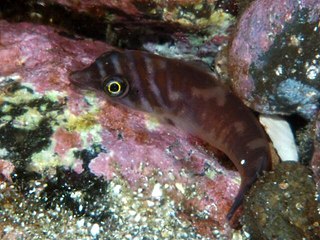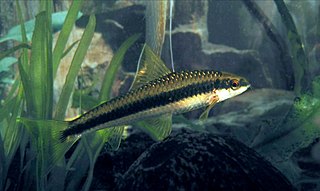
Cyprinidae is a family of freshwater fish commonly called the carp or minnow family, including the carps, the true minnows, and their relatives the barbs and barbels, among others. Cyprinidae is the largest and most diverse fish family, and the largest vertebrate animal family overall, with about 3,000 species; only 1,270 of these remain extant, divided into about 200 valid genera. Cyprinids range from about 12 mm (0.5 in) in size to the 3 m (9.8 ft) giant barb. By genus and species count, the family makes up more than two-thirds of the ostariophysian order Cypriniformes. The family name is derived from the Greek word kyprînos.

Cypriniformes is an order of ray-finned fish, which includes many families and genera of cyprinid fish, such as barbs, gobies, loaches, botias, and minnows. Cypriniformes is an “order-within-an-order”, placed under the superorder Ostariophysi—which is also made up of cyprinid, ostariophysin fishes. The order contains 11-12 families, over 400 genera, and more than 4,250 named species; new species are regularly described, and new genera are recognized frequently. Cyprinids are most diverse in South and Southeast Asia, but are entirely absent from Australia and South America. At 112 years old, the longest-lived cypriniform fish documented is the bigmouth buffalo.

Cobitidae, also known as the True loaches, is a family of Old World freshwater fish. They occur throughout Eurasia and in Morocco, and inhabit riverine ecosystems. Today, most "loaches" are placed in other families. The family includes about 260 described species. New species are being described regularly.

The black carp or Chinese black roach is a species of cyprinid freshwater fish and the sole extant species of the genus Mylopharyngodon. It is native to lakes and rivers in East Asia, ranging from the Amur Basin across China to Vietnam. One of the largest cyprinids in the world, the black carp has a typical length of 60–120 cm (23.5–47 in), though it can reach up to 1.9 m in length and 109 kg (240 lb) in weight. It is carnivorous and generally feeds on invertebrates such as snails, clams and mussels.

The Anostomidae are a family of ray-finned fishes that belong to the order Characiformes. Closely related to the Chilodontidae and formerly included with them, the Anostomidae contain about 150 described species. Commonly known as anostomids, they are found in freshwater habitats from the Río Atrato in northernmost South America to warm-temperate central Argentina; they are of Amazon origin, with few found west of the Andes. Their scientific name approximately means "mouth on top", from Ancient Greek áno- (ἄνω) "up" + stóma (στόμᾶ) "mouth", in reference to the arrangement of these fishes' mouth opening.

Danionella is a genus of danionin fish found in freshwater habitats in Myanmar and West Bengal, India. It includes some of the smallest fishes.

Clingfishes are fishes of the family Gobiesocidae, the only family in the order Gobiesociformes. These fairly small to very small fishes are widespread in tropical and temperate regions, mostly near the coast, but a few species in deeper seas or fresh water. Most species shelter in shallow reefs or seagrass beds, clinging to rocks, algae and seagrass leaves with their sucking disc, a structure on their chest.

Garra is a genus of fish in the family Cyprinidae. These fish are one example of the "log suckers", sucker-mouthed barbs and other cyprinids commonly kept in aquaria to keep down algae. The doctor fish of Anatolia and the Middle East belongs in this genus. The majority of the more than 160 species of garras are native to Asia, but about one-fifth of the species are from Africa.

The bitterling-like cyprinids form the cyprinid subfamily Acheilognathinae. This subfamily contains seven genera, although the Khanka spiny bitterling is often placed in Acheilognathus, and at least 75 described species to date. Over half of the species are in the genus Acheilognathus.

Pharyngeal teeth are teeth in the pharyngeal arch of the throat of cyprinids, suckers, and a number of other fish species otherwise lacking teeth.

Labeoninae is a doubtfully distinct subfamily of ray-finned fishes in the family Cyprinidae of order Cypriniformes. They inhabit fresh water and the largest species richness is in the region around southern China, but there are also species elsewhere in Asia, and some members of Garra and Labeo are from Africa. They are a generally very apomorphic group, perhaps the most "advanced" of the Cyprinidae. A common name for these fishes is labeonins or labeoins.

Barilius evezardi is a fish in genus Barilius of the family Cyprinidae. It is found in Maharashtra of India, specifically in the upper reaches of rivers on hills.
Tariqilabeo bicornis, the bihorned barbel, is a species of fish in the family Cyprinidae. This fish reaches up to 15 or 16 centimeters in length. It is found in the upper Salween River in Yunnan, Thailand and Myanmar.
Belligobio is a small genus of cyprinid fishes containing two recognized species endemic to China. The type species of Belligobio is Belligobio eristigma, a synonym of Hemibarbus mylodon, and this taxa is not currently classified in Belligobio and some authorities suggest that Belligobio is a sub-genus within Hemibarbus.
Xenophysogobio is a genus of cyprinid fish endemic to China. There are currently two described species in this genus.

Most bony fishes have two sets of jaws made mainly of bone. The primary oral jaws open and close the mouth, and a second set of pharyngeal jaws are positioned at the back of the throat. The oral jaws are used to capture and manipulate prey by biting and crushing. The pharyngeal jaws, so-called because they are positioned within the pharynx, are used to further process the food and move it from the mouth to the stomach.

Squalius valentinus, commonly known as the Valencia chub and the Levantine bagra, is a species of freshwater fish in the carp family Cyprinidae. It was first isolated from the Turia River in Valencia, hence its name. It is considered endangered. This species is differentiated from its cogenerates by having eight branched rays in its dorsal fin; eight branched rays in its anal fin; two rows of pharyngeal teeth on both sides possessing 2 and 5 teeth ; a wide caudal peduncle; its number of gill rakers; the number of scales in its lateral line; the number of scale rows above the latter; by possessing three scale rows below it; by having thirty-nine vertebrae ; showing large 4th and 5th infraorbital bones; a maxilla with a very distinct marked anterior process; exhibiting a frontal bone expanded at the middle; a wide neurocranium bone; the lower branch of the pharyngeal bone being robust; a large and narrow urohyal; as well as genetic differences (allozymes).

Squaliobarbinae is a small subfamily of the carp and minnow family, Cyprinidae, which consists of three monotypic genera which have their natural distributions in eastern Asia. Two species, the grass carp and the black carp, have been introduced to other parts of the world for weed control and aquaculture. They are large cyprinids characterised by an enlarged subtemporal fossa, the palate articulating with the supraethmoid, an enlarged intercalar bone in the cranial vault, and a divided levator posterior muscle.

Xenocyprinae, is a contentious subfamily of the family Cyprinidae, the carp and minnow family, originally from eastern Asia.

Girella zebra, also known as zebrafish or stripey bream, is a species of marine ray-finned fish, a sea chub in the family Kyphosidae. It lives in the Indo-Pacific, where it is endemic to the coastal waters of the southern parts of Australia.
















